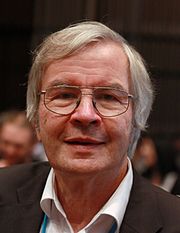
Nobel Prize Winner Public Lecture
Title: Laser Frequency Combs: Applications from the Atomic to the Cosmic Scale
Speaker: Theodor W. Hansch, Max-Planck-Institute of Quantum Optics, Garching, Faculty of Physics, Ludwig-Maximilians-University, Munich, Germany
Time and place: 10:00-11:30a, October 26, 2012, Room 111, Physics Building
Abstract:
The spectrum of a frequency comb, commonly generated by a mode-locked femtosecond laser consists of several hundred thousand precisely evenly spaced spectral lines. Such laser frequency combs have revolutionized the art measuring the frequency of light, and they provide the long-missing clockwork for optical atomic clocks. The invention of the frequency comb technique has been motivated by precision laser spectroscopy of the simple hydrogen atom. The availability of commercial instruments is facilitating the revolution of new applications far beyond the original purpose, ranging from fundamental research to telecommunications and satellite navigation. Laser comb techniques give control of the electric field of ultrashort laser pulses, and they have developed into key tools for the emerging field of attosecond science. Laser combs are becoming powerful instruments for broadband molecular spectroscopy by dramatically improving the resolution and recording speed of Fourier spectrometers. The calibration of astronomical spectrographs with laser combs will enable new searches for earth-like planets in distant solar systems and may reveal the continuing expansion of space in the universe.
Biography:
 Theodor Wolfgang Hänsch (b. 30 October 1941 in Heidelberg, Germany) is a German physicist. He received one fourth of the 2005 Nobel Prize in Physics for "contributions to the development of laser-based precision spectroscopy, including the optical frequency comb technique", sharing the prize with John L. Hall and Roy J. Glauber.
Theodor Wolfgang Hänsch (b. 30 October 1941 in Heidelberg, Germany) is a German physicist. He received one fourth of the 2005 Nobel Prize in Physics for "contributions to the development of laser-based precision spectroscopy, including the optical frequency comb technique", sharing the prize with John L. Hall and Roy J. Glauber.
Hansch gained his diploma and doctoral degree from Ruprecht-Karls-Universität Heidelberg in 1960s. Subsequently, he became a professor at Stanford University, California from 1975 to 1986. He was awarded the Comstock Prize in Physics from the National Academy of Sciences in 1983. In 1986, he received the Albert A. Michelson Medal from the Franklin Institute. In the same year Hänsch returned to Germany to head the Max-Planck-Institut für Quantenoptik. In 1989, he received the Gottfried Wilhelm Leibniz Prize of the Deutsche Forschungsgemeinschaft, which is the highest honour awarded in German research. In 2005, he also received the Otto Hahn Award of the City of Frankfurt am Main, the Society of German Chemists and the German Physical Society. In that same year, the Optical Society of America awarded him the Frederic Ives Medal and the status of honorary member in 2008. One of his students, Carl E. Wieman, received the Nobel Prize in Physics in 2001.
Next:Special Colloquium: The role of exact results in condensed matter physics (Y.P. Wang, Oct.25, 2012) Back




